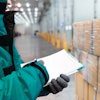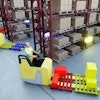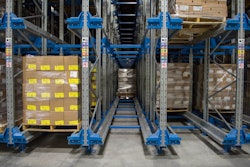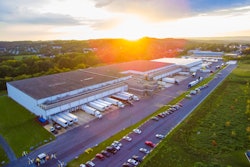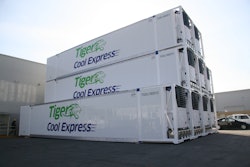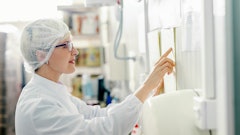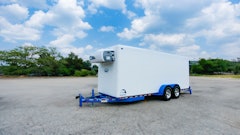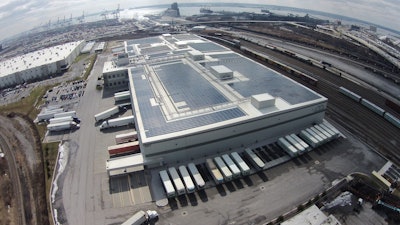
The cold chain logistics business is booming as improved technologies and counter-cyclical growing seasons in many parts of the world have made it possible to transport fresh, perishable foods from international to American ports. In addition to this extension of the global supply chain, consumers’ demand for an array of healthy, nutritious foods—both chilled and frozen—is placing further pressure on cold storage providers to accommodate a growing perishables cold chain, at both key ports and inland locations.
As the demand for cold storage continues to outpace supply, shippers continue to look to partners willing to front the capital investments necessary to build the highly-automated and advanced cold storage facilities of tomorrow.
“There's huge demand growth and demand spike for cold chain distribution to support not only the population growth, but also the shifting manufacturing and production footprints that are out there,” explains Carl Fowler, senior vice president of regional sales at Americold.
Log in to view the full article
The cold chain logistics business is booming as improved technologies and counter-cyclical growing seasons in many parts of the world have made it possible to transport fresh, perishable foods from international to American ports. In addition to this extension of the global supply chain, consumers’ demand for an array of healthy, nutritious foods—both chilled and frozen—is placing further pressure on cold storage providers to accommodate a growing perishables cold chain, at both key ports and inland locations.
As the demand for cold storage continues to outpace supply, shippers continue to look to partners willing to front the capital investments necessary to build the highly-automated and advanced cold storage facilities of tomorrow.
“There's huge demand growth and demand spike for cold chain distribution to support not only the population growth, but also the shifting manufacturing and production footprints that are out there,” explains Carl Fowler, senior vice president of regional sales at Americold.
Much of the cold chain infrastructure that exists today was designed to match the way we historically fished, farmed and produced, Fowler adds. For example, most of the fish that Americans consume comes from the Pacific, but there is still a large concentration of facilities in the Northeast that support the fishing industry. More cold storage is needed on the West Coast, however, to follow the industry’s evolution.
But cold storage facilities are extremely expensive, and many companies are unable to make the investment on their own.
“[This] speaks to why there's such a constraint, because companies, producers, growers and manufacturers don't really want to sink their capital into cold chain infrastructure; they'd rather leverage partners to do that,” Fowler notes, adding that third-party logistics (3PL) providers take on that risk by understanding the evolution of food and how it is produced, grown, manufactured and consumed.
Changing Buying Habits
The food and beverage industry has become increasingly complex in today’s global supply chain, and changing consumer buying habits are driving innovation inside cold storage facilities as warehouse operators learn how to manage the proliferation of fresh, perishable and frozen foods.
“As family demographics have changed and people are looking for faster, quick-prepared food, frozen is certainly filling that niche,” says Ernie Ferguson, vice president of sales and marketing for MTC Logistics. “You don’t need to do anything more than think about the number of aisles at the grocery store filled with frozen food cases versus five years ago.”
A larger mix of frozen and fresh goods, however, entails a wide range of storage temperature requirements. A room full of strawberries, for example, will not thrive in the same room as ice cream.
“Cold treatment for produce is different than it is for vegetables than it is for bakery. Thus, having the site flexibility to not only turn the temperature dial but to compartmentalize the asset by building walls in rooms that are flexible enough to match shifting demand requires significant capital investment,” notes Fowler.
“One of the most difficult things to do in this industry is to forecast what demand is going to be two, three and four years out. Skew proliferation in our grocery retail outlets is exponentially higher than what it was 10 years ago, so that corresponds with the complexity and variety of temperature zones that we need to support for downstream distribution activity,” he adds. “The best way that we've found to do that is through collaboration on what demand looks like and what's needed.”
Americold works with it partners to understand the temperature profiles of the participants in their markets. This creates an opportunity to have flexibility in the types of products its partners can serve and is especially important, Fowler says, when retrofitting an existing facility.
“You have to have a strong view on what the market demand is in that geography before you invest all that capital to convert an existing facility,” he adds.
According to Greg Lehmkuhl, president and CEO of Lineage Logistics, companies have been forced to move closer to their customers in order to create these profiles, which help them understand and predict their customers’ buying behavior. In turn, cold storage facilities are now also moving closer to their customers.
“By collaborating and sharing data with both the suppliers and the retailers, we are helping to dramatically change the way product moves through the supply chain and ensure fresher, more convenient items that are available when and where the consumer wants it,” he adds.
In addition to a shift in asset location and variable temperature capabilities, the modern cold storage facility has become increasingly complex, featuring more automation, robotics and technological innovation.
New facilities often feature in-floor heating to prevent moisture from freezing and prevent the cement from cracking as well as internal storage areas to support different temperature zones. Drains and water reclamation plans are common when dealing with produce or floral, and the ability to handle other value-added services is essential. Fresh produce that has a short shelf-life such as apples, oranges and kiwis require quicker turns, which means your warehouse also must be able to support increased traffic to and from your facility.
“Our customers are looking for more complex supply chain solutions,” adds MTC Logistics’ Ferguson. “When I got into the cold storage side of the business almost 20 years ago, it was really about moving a lot of full pallets through the facilities. Now, we're touching cases constantly. We also have customers that are looking for us to do different things that might traditionally be done at the processing plant.”
MTC Logistics broke ground in December on a 300,000 square-foot, $58 million, cold storage facility on property owned by the Alabama State Port Authority in Mobile, Alabama. This new facility will feature advanced automation and technology to address a lack of labor availability and the increased turns required for temperature-sensitive product. Specifically, a relatively new-to-the-U.S. technology called mobile racking will increase the number of rack pallets in position within a facility to maximize space, which is especially important in facilities around ports and on the East Coast and the Southeast where there's a limited amount of land and a premium cost.
MTC Logistics is also considering the installation of an automated storage and retrieval system (ASRS), which is even more automated than a mobile racking system.
“[In Mobile] we're looking to be cognizant of that labor component,” Ferguson says. “Demand will continue to increase as the economy maintains strength. We've got to find ways to automate the facilities more because of the labor situations that we're all dealing with.”
Expansion of the Global Supply Chain
While investments at ports have historically been low, the globalization of the food supply chain has created increased demand for import and export services.
“In the last 10 to 15 years, The economy has certainly become a true global economy, and food is a big driver of that,” says Ferguson.
“From an export standpoint, the U.S. is positioned in a fantastic way to help feed the world, thanks to what we do in the Midwest providing low-cost grain, poultry, pork and beef,” he adds.
Many cold storage facility operators are now making moves to support global trade at key ports across the United States. MTC Logistics’ new Mobile facility, for example, will enhance the port’s containerized operations to reach more markets throughout the world. All of the product will transit in on containers and will be processed through APM Terminals before or after arriving at MTC Logistics, where they will be able to blast freeze poultry product coming from across the Southeast to be exported across the globe. Americold, whose Atlanta headquarters is situated in the heart of poultry country, also sees a need for port infrastructure to support the protein exports for the poultry industry coming out of this region to foreign markets.
“Companies have really been left to their own devices in piecing together sub-optimal supply chains to service that international downstream demand because there just hasn't been an investment in those port assets,” says Americold’s Fowler.
In regards to fresh food imports, Fowler says there has been under investment there as well. While counter-cyclical growing seasons in Southern Europe, Latin American and Asia-Pacific have made products available year-round for U.S. consumers, he says, “there hasn't been a whole lot of supporting infrastructure at those ports to facilitate the cost-effective flow of goods.
“And when you're talking about fresh, the clock is always ticking, so it's not only being cost effective but also being able to support rapid deployment and speed to market,” he adds. “It forces a different view of infrastructure and value-add services for things like modified atmosphere where you can treat the product coming in to extend shelf life in a safe way.”
In February, Americold made a significant investment to back the demand for fresh foods. In conjunction with the acquisition of PortFresh Holdings, a temperature-controlled operator servicing fresh produce trade primarily through the Port of Savannah, Americold plans to build a 15 million-cubic-foot cold storage facility on port adjacent to land owned by PortFresh.
The facility will feature 37,000 pallet positions, advanced blast freezing capabilities, and space and infrastructure to support refrigerated-containerized trade.
“With this investment, Americold is fulfilling our customers’ requests to expand into this growing market, which provides an efficient and cost-effective solution to meet their import and export needs," says Fred Boehler, president and chief executive officer of Americold Realty Trust.
Follow Amy Wunderlin on Twitter.


